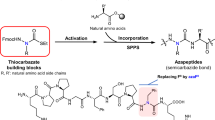Summary
Molecular modeling studies of potent decapeptide bradykinin antagonists suggested the de novo design of peptide mimetics based on a 1,2,3,4-tetrasubstituted 1,4-piperazin-6-one scaffold. These de novo-designed antagonists exhibited only modest potency (IC50 ∼ 55 μM) on a cloned human B2 receptor and antagonist activity in an in vitro human-cell functional assay. The success of these structures led to the creation of prototype libraries based on variously substituted 1,4-piperazine scaffolds, which allowed a rapid and general search of pharmacophores attached to a piperazine scaffold. The parent piperazinedione structures and fully reduced piperazine libraries differ from recently reported diketopiperazine libraries in the use of diverse nonnatural amino acids, on-resin-submonomer synthesis to provide more diverse N-substituted structures, and the adaptation of simultaneous ring closure and resin cleavage to drive the formation of highly hindered amide bonds. Using this chemistry, a rationally directed non-peptide library of approximately 2500 N,N′-disubstituted piperazines and piperazinediones was synthesized and screened for ligand affinity on bradykinin, neurokinin, and opioid receptors. A number of lead structures were identified. Notably, a bradykinin antagonist lead, CP-2458, with good receptor selectivity and antagonist activity in human-cell assays was identified and is undergoing optimization by traditional and combinatorial methods.
Similar content being viewed by others
Abbreviations
- BK:
-
bradykinin
- Boc:
-
tert-butoxycarbonyl
- Cbz:
-
carboxybenzyl
- DMF:
-
dimethylformamide
- DMSO:
-
dimethylsulfoxide
- Fmoc:
-
fluorenylmethoxycarbonyl
- HBTU:
-
O-benzotriazol-l-yl-N,N,N′,N′-tetramethyluronium hexafluorophosphate
- HPLC:
-
high-performance liquid chromatography
- MALDI-MS:
-
matrix assisted laser desorption ionization-mass spectrometry
- PyBroP:
-
bromo-tris-pyrrolydino-phosphonium hexafluorophosphate
- RDDA:
-
rationally directed diverse analogs
- TFA:
-
trifluoroacetic acid
References
Witherup, K.M., Ransom, R.W., Varga, S.L., Pitzenberger, S.M., Lotti, V.J. and Lumma, W.C.,Pyrroloquinoline bradykinin antagonists, WO 94/09001, 1994.
Mobilio, D. and Musser, J.H.,N-Substituted aminoquinolines as analgesic agents, U.S. Patent 5,216,165 (1993).
Musser, J.H., Molinari, A.J. and Mobilio, D.,Substituted quinolinyl and napthalenylbenzamides, U.S. Patent 5,212,182 (1993).
Oku, T. and Kayakiri, H.,Heterocyclic compounds as bradykinin antagonists, EP 94106486.7 (1994).
Sawutz, D.G., Salvino, J.M., Dolle, R.E., Casiano, F., Ward, S.J., Houck, W.T., Faunce, D.M., Douty, B.D., Baizman, E., Awad, M.M.A., Marceua, F. and Seoane, P.R.,The non-peptide WIN 64338 is a bradykinin B2 antagonist, Proc. Natl. Acad. Sci. USA, 91 (1994) 4693–4697.
Goodfellow, V.S., Marathe, M.V., Kuhlman, K.G., Fitzpatrick, T.D., Hanson, W., Zuzack, J.W., Ross, S.E., Wieczorek, M., Burkard, M. and Whalley, E.T.,Bradykinin receptor antagonists containing N-substituted amino acids: In vitro and in vivo B 2 and B 1 receptor antagonist activity, J. Med. Chem., 39 (1996) 1472–1484.
Gordon, D.W. and Steele, J.,Reductive alkylation on a solid phase: Synthesis of a piperazinedione combinatorial library, Bioorg. Med. Chem. Lett., 5 (1995) 47–50.
DeWitt, S.H., Kiely, J.S., Stankovic, C.J., Schroeder, M.C., Cody, D.M. and Pavia, M.R.,Diversomers: An approach to non-peptide, non-oligomeric chemical diversity, Proc. Natl. Acad. Sci. USA, 90 (1993) 6909–6913.
Hocart, S.J., Murphy, W.A. and Coy, D.H.,Analogs of growth hormone releasing factor (1–29) amide containing the reduced peptide-bond isostere, J. Med. Chem., 33 (1990) 1954–1958.
Gubert, S., Braojos, C. and Ortiz, J.A.,A convenient synthesis of parent and 2-substituted octahydro-2H-pyrazino[1,2-a]-pyrazines, Synthesis, (1991) 318–319.
Bernatowicz, M.S., Matsueda, G. and Wu, Y.,1H-Pyrazole-1-carboxamidine hydrochloride: An attractive reagent for guanylation of amines and its application to peptide synthesis, J. Org. Chem., 57 (1992) 2497–2502.
Douty, B.D., Salvino, J.M., Seoane, P.R. and Dolle, R.E.,Synthesis of non-peptide bradykinin B 2 receptor antagonists, Bioorg. Med. Chem. Lett., 5 (1995) 363–366.
Author information
Authors and Affiliations
Rights and permissions
About this article
Cite this article
Goodfellow, V.S., Laudeman, C.P., Gerrity, J.I. et al. Rationally designed non-peptides: Variously substituted piperazine libraries for the discovery of bradykinin antagonists and other G-protein-coupled receptor ligands. Mol Divers 2, 97–102 (1996). https://doi.org/10.1007/BF01718706
Received:
Accepted:
Issue Date:
DOI: https://doi.org/10.1007/BF01718706




